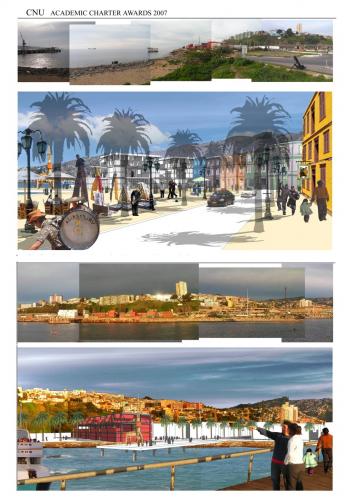
A Response to the Current Development of Valparaiso’s Waterfront
Location: Valparaiso, Chile. Industrial Chilean waterfront town
This project is the product of a thesis submitted to the faculty of the Graduate School of Univ. of Maryland, College Park, in partial fulfillment of the requirements for the degree of Master of Architecture in December 2006.
The thesis evolved from the concern for Valparaiso's waterfront master plan proposal and its negative implications on the existing infrastructural, social, cultural, and economic contexts. The student developed an analysis of the site based on the assessment of these contexts, and as a point of departure documented the city's genius loci. The city's bohemian culture and people, eclectic architecture, murals and public art, 35 hills, historic cable cars, and network of stairs, are part of a unique quilt heritage that needs incorporated or acknowledged in the new development.
The student evaluated and critiqued the city's master plan, and developed a response at three scales: the neighborhood scale, the district scale, and the building scale. The project is a response to a development plan for Valparaiso, Chile's waterfront which is currently alienated from teh city by train tracks and a raised highway and is used limited to the shipping and warehousing industry. While the city's master plan aims to provide an urban and tourist impetus to the district, it may actually weaken the port-city relationship as it disregards Valparaiso's current socio-economic and infrastructujral conditions as well as its genius loci.
The current plan disregards the current street grid, view corridors, and architectural strengths and threatens the city's strong small business/artisan economic base. This project proposes a new master plan at the waterfront complete with a new Urban Marketplace District that connects directly to the nearby neighborhoods. The proposed new urban framework is based on the city's historic grid and fabric, and creates a series of neighborhoods accessible to and compatible with the existing city. The plan removes the raised highway, fences, and blighted buildings and adds five civic spaces and an open green as well as a pedestrian boulevard by extending Avenida Argentina. The Marketplace District consists of a first light-rail station in the city, the "Persian" Market and Food Market buildings, in line with the city's mixed use strength. There is also an artisan market and many proposed structures recycle local vernacular and materials.
Overall, the plan complements the city's existing strengths and generates opportunity and growth for the local and regional community.
Transect Zone(s): T4 general, T5 center, T6 core.
Status: Proposed
Project or Plan's Scale: District
Features: Civic buildings & parks, Mixed uses, Sustainable infrastructure, Waterfront.
Land area (in acres): 55
Total built area (in sq. ft.):
Total project cost (in local currency):
Retail area (in sq. ft.):
Office area (in sq. ft.):
Industrial area (in sq. ft.):
Number of hotel units:
Number of residential units (include live/work):
Civic uses (type and size): Plaza, light rail station, markets, parks, waterfront boulevard
Parks & green space (in acres):
Project team designers: University of Maryland, College Park, Alejandra Hernandez - student designer
Project team developers: NA
Previous site status: Redevelopment
Starting/Ending date of construction/implementation: -




